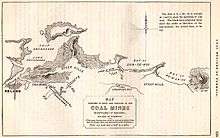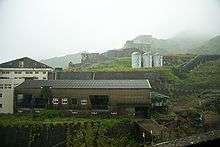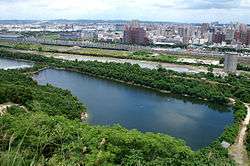Mining in Taiwan
Mining in Taiwan used to be a great industry, especially for sulfur, clay, gold and coal. Nowadays, Taiwan lacks natural resources for mining and relies on imports to meet its demand for minerals. The current mining industries in Taiwan are of small and medium size in terms of exploited minerals and the scale of mining, mainly focusing on marble and limestone for cement, stone and craft industries and sand and gravel for construction industries.[1] Mining activities in Taiwan are regulated by the Bureau of Mines of the Ministry of Economic Affairs.
History of mining

Mining activities in Taiwan began during Qing Dynasty rule when the island used to have more than 200 types of minerals. The main sources of minerals were the mountain regions where many Taiwanese aborigines resided. Mining at that time was a difficult and challenging pursuit.
After the opening of port access by the government, more Europeans came to the island for ship refueling. There was rampant theft and illegal sale of coal during this era thus the government prohibited the activity. After a while, seeing that mining activities benefited rich Taiwanese and that it could benefit the Qing army, the government lifted the prohibition due to a fear that Europeans would take the mines by force. Mining industries were then developed progressively by both the government and private sectors.[2]
Economy
As of 2013, mineral products accounted for 10% of Taiwan export value. The sector also employs 2,758 workforce.[3]
Types of mining
Aluminium
Taiwan consumed about 180,000 tonnes of aluminium alloy in 2013, in which it went to the electronics sector (41%), packing (26%), construction (9%), machinery (8%) and others (16%). The CS Aluminium Corp., subsidiary of China Steel Corporation, produced 167,000 tonnes of aluminium in 2010.[3]
Cement

Around 80% of Taiwan's cement are mined and produced in Eastern Taiwan. In 2013, the output capacity was 26 million tonnes per year. In that year, Taiwan produced 16 Mt of cement and consumed 12 Mt. Cement are exported to Ghana, Malaysia, Indonesia, Mauritius and Australia.[3] Cement mining in Taiwan is mostly done by Taiwan Cement or Asia Cement Corporation in which its plant in Hualien County contributes to nearly 29% of Taiwan's cement production.[4]
Limestone mining was done in Zuoying District, Kaohsiung in an area what used to be a part of Mount Banping. In 1997, the mining activities ceased to operate. The abandoned site has now been turned into the Banping Lake Wetland Park for tourism by the Kaohsiung City Government.[5]
Coal
Coal is distributed mainly in northern Taiwan. All of the commercial coal deposits occurred in three Miocene coal-bearing formations, which are the Upper, the Middle and the Lower Coal Measures. The Middle Coal Measures was the most important with its wide distribution, great number of coal beds and extensive potential reserves. Taiwan has coal reserves estimated to be 100-180 Mt. However, coal output had been small, amounting to 6,948 metric tonnes per month from 4 pits before it ceased production effectively in 2000.[6] The abandoned coal mine in Pingxi District, New Taipei has now been turned into the Taiwan Coal Mine Museum, while the one in Houtong has been turned into Houtong Cat Village.[7]
Copper

Copper mining, as well as gold, used to take place in Jinguashi town in Ruifang District, New Taipei. In 1904, arsenic-copper sulfate mineral enargite was found at the No. 3 Mine in the area when miners dug deeper, increasing the amount of copper minerals discovered. From that moment, the focus of the mining in the area shifted from gold and silver to gold, silver and copper. After the liberation of Taiwan in 1945, the state-run Taiwan Gold and Copper Mining Bureau was established in 1946 and renamed to Taiwan Metals Mining Company in 1955. As copper production gradually increased over the years, Jinguashi mining area maintained excellent operating performance. However, after 1973, the gold and copper output began to decline. In order to increase the production, the company started large-scale open-pit mining in 1978 and shifted its focus to mineral refining and processing. To boost their mineral processing capabilities, the company took out bank loans in 1981 to build the Lile Copper Refinery in the area located at the Golden Waterfall today. Because of a collapse in the world copper price few years later, the company was unable to repay its loans and went out of business in 1987. The Taiwan Sugar Corporation assumed ownership of the land in Jinguashi and the mining in that area came to an end.[8]
Gold
Taiwan has four gold-bearing deposits with metal content estimated at 100 tonnes. Three of the deposits are concentrated in the central mountain range, while the fourth one is at Pingfeng Mountain in the north. Jinguashi Mine is one of the biggest gold deposit, located in Ruifang District, New Taipei. The Gold Ecological Park was established within the area which houses the Gold Museum. Quartz was often found at the same rate as gold.
Oil and gas

Oil was firstly discovered in Taiwan in Gongguan Township, Miaoli County at the Chuhuangkeng oilfield. Oil has been drilled since the Qing Dynasty rule of Taiwan in 1877. It was then done by the more advanced development stage by the Japanese when they drilled around 98 oil wells. The original site of the first oil well in Taiwan has now turned into the Taiwan Oil Field Exhibition Hall.[9] Oil exploration in Taiwan is controlled by the CPC Corporation. Deep drilling in Taiwan began in 1959 when the CPC drilled to a depth up to 4,063 meters which they brought out more than 110,000 m3 of natural gas and 10,000 liters condensate daily. Offshore drilling began in 1973 when their rig went down 3,661 meters under the ocean off the coast of Hsinchu County with no result.[10] In January 2013, Taiwan had 2 million barrels of proven oil reserves.[11] In 2012, Taiwan produced 22,000 barrels/day of oil. In 2007, the capacity of Taiwan oil refinery was 1,197,000 barrels/day due to its large refinery sectors.[12] In 2012, Taiwan planned to explore oil offshore of Taiping Island in Qijin District, Kaohsiung City.[13]
Taiwan produces a small amount of natural gas. Gas exploration in Taiwan is also controlled by the CPC Corporation. It also cooperates with China National Offshore Oil Corporation in exploring natural gas in the Taiwan Strait.[11] In 2004, natural reserved was discovered in Guantian Township, Tainan County. In July 2010, the CPC discovered natural gas reserves in Gongguan Township, Miaoli County which was estimated to have a production capacity of at least 1 billion m3.[14] In March 2013, Taiwanese oceanic research team discovered gas hydrate deposits in water south of Pratas Islands, Kaohsiung City in the South China Sea through reflection seismology and sub-bottom profiling data.[15]
Energy usage
In 2014, mining sector consumed a total of 474.4 GWh of electricity.[6]
Tourism
Sites for mining-related tourism in Taiwan include:
See also
References
- ↑ "Mining in Taiwan (ROC) - Overview". Mbendi.com. Retrieved 2014-05-26.
- ↑ "Westernized Mining - 台灣大百科全書 Encyclopedia of Taiwan". Taiwanpedia.culture.tw. 2014-03-11. Archived from the original on 2014-05-28. Retrieved 2014-05-26.
- 1 2 3 "Taiwan [advance release]" (PDF). 2013 Minerals Yearbook. U.S. Geological Survey.
- ↑ Kuo, Chia-erh (13 June 2017). "Asia Cement denies mine site in Hualien expanded". Taipei Times. Retrieved 13 June 2017.
- ↑ "A Symphony of Water and Green-Towards a Rebirth of Caogong Canal and a New Fragrant Waterfront Kaohsiung". Library.taiwanschoolnet.org. Retrieved 2014-05-28.
- 1 2 "Energy Statistical annual Reports". Bureau of Energy, Ministry of Economic Affairs.
- ↑ "Coal Mining in Taiwan (ROC) - Overview". Mbendi.com. Archived from the original on 2015-10-17. Retrieved 2014-05-26.
- ↑ "Historical background". Taiwan.gov.tw. Archived from the original on 2014-05-27. Retrieved 2014-05-27.
- ↑ "Culture and Tourism Buresu of Miaoli - Taiwan Oil Field Exhibition Hall". Miaolitravel.net. 2012-12-20. Retrieved 2014-05-26.
- ↑ "ROC still digging hard to find more oil, gas". Taiwan Info. 4 October 1981. Archived from the original on 6 October 2014.
- 1 2 "U.S. Energy Information Administration (EIA)". eia.gov. Retrieved 2014-08-23.
- ↑ "Oil and Gas in Taiwan (ROC) - Overview". mbendi.com. Retrieved 2014-08-23.
- ↑ "Taiwan to start oil exploration in S China Sea". Taipei Times. 2014-05-20. Retrieved 2014-05-26.
- ↑ Chen, Kevin (30 July 2010). "CPC Corp, Taiwan finds gas reserves at old Miaoli well". Taipei Times.
- ↑ "Taiwan finds gas hydrates deposts in South China Sea". naturalgasasia.com. Retrieved 2014-08-23.
| Wikimedia Commons has media related to Mines in Taiwan. |
